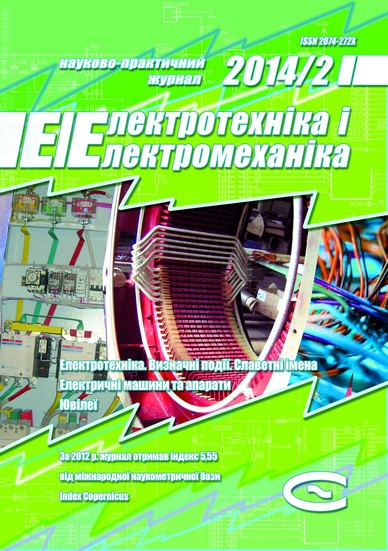Modeling of dynamic characteristics of a nonlinear oscillatory system with a magnetic spring. Part 1.
DOI:
https://doi.org/10.20998/2074-272X.2014.2.03Keywords:
finite element method, permanent magnet, vibration isolatorAbstract
A passive magnetic vibration isolator (a magnetic spring) with cylindrical magnets is considered. A mathematical model is developed to calculate magnetic spring magnetic field and force. Numerical calculation of the vibration isolator magnetic field via a 3-D finite element method is performed. Experimental results presented prove adequacy of the computational data.
References
Choi K.B. Stabilization of one degree of freedom control type levitation table with magnet repulsive forces. J. Mechatronics, 2003, v.13, no.6, pp.587-603.
Bonisoli E. Passive effects of rare-earth permanent magnets on flexible conductive structure. J. Mech. Res. Commun., 2007, v.37, no.4.
Carrella A. On the design of a high-startic-low dynamic stiffness isolator. J. Sound Vib., 2008, v.315, no.3.
Puppin E., Fratello V. Vibration isolation with magnet springs. J. Rev. Sci. Instrum., 2002, v.73, no.11, pp. 4034-4036.
Yonnet J.P. Permanent magnet bearing and coupling. IEEE Mag., 1981, v.17, no.1.
Downloads
Published
How to Cite
Issue
Section
License
Copyright (c) 2015 R. P. Bondar, I. S. Chebotarun, A. D. Podoltsev

This work is licensed under a Creative Commons Attribution-NonCommercial 4.0 International License.
Authors who publish with this journal agree to the following terms:
1. Authors retain copyright and grant the journal right of first publication with the work simultaneously licensed under a Creative Commons Attribution License that allows others to share the work with an acknowledgement of the work's authorship and initial publication in this journal.
2. Authors are able to enter into separate, additional contractual arrangements for the non-exclusive distribution of the journal's published version of the work (e.g., post it to an institutional repository or publish it in a book), with an acknowledgement of its initial publication in this journal.
3. Authors are permitted and encouraged to post their work online (e.g., in institutional repositories or on their website) prior to and during the submission process, as it can lead to productive exchanges, as well as earlier and greater citation of published work.





